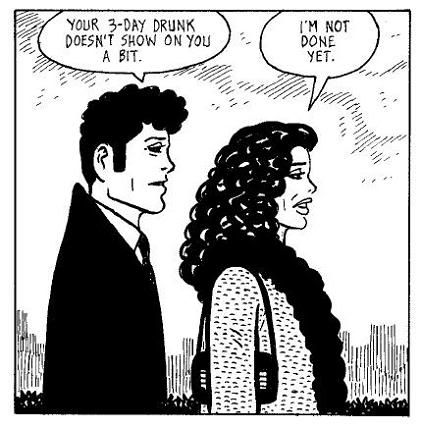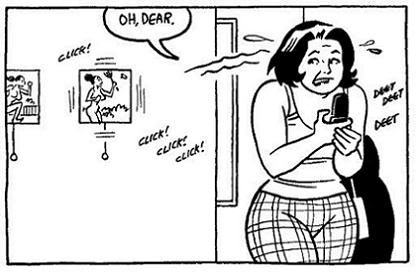

Love and Rockets: New Stories #4 (Fantagraphics) - Gilbert and Jaime Hernandez have been writing and drawing Love and Rockets for so long now that their newest work has become like the ever-growing peak of a tremendous mountain that stretches back through all previous incarnations of the series and the iconic characters that they keep returning to. New Stories is the third volume of Love and Rockets, published on a yearly schedule in a squat bookshelf-ready format meant to take advantage of the increasing shift away from magazine-format comics.
In this volume, Gilbert offers up a two-part tale, of which the first is a pulpy vampire riff in the style of his series of fake B-movie "adaptations." While seemingly a standalone story full of all the usual Gilbert tropes — big-boobed women, sex, violence, monsters and supernatural occurrences — Gilbert's second story, later in the book, follows the lead actress from this movie into her ordinary life. I can't quite tell who this character is, if she's someone from previous Love and Rockets stories or not. It's not Fritz, the star of Gilbert's other B-movie comics, so my best guess is Mark Herrara's (ex-)wife Mila, who appeared in the Fritz stories that eventually formed the collection High Soft Lisp. But quite frankly all of Gilbert's big-boobed, tiny-waisted women are starting to look the same, and his genre comics are weird and entertaining but not as substantial or enduring as the work he used to do in his prime, in the old Palomar stories and even in much of the post-Palomar work concerning Luba and her top-heavy sisters. Like most of Gilbert's B-movie comics, "King Vampire" is beautifully drawn — even considering the grotesquely proportioned main character and a similar-looking vampiress who kind of looks like Luba — but feels a bit empty and unsatisfying. Much like the kind of trashy sexploitation flicks that Gilbert is channeling here, I suppose.
Gilbert's other piece in this issue, "And Then Reality Kicks In," is another story altogether. This fifteen-page short is the kind of elliptical, emotionally charged storytelling that Gilbert does best, where all of the substance lingers unspoken between the lines, slowly accumulating force through his whimsical, charming dialogue. Indeed, this piece is all about dialogue; it's a conversation between the actress from the vampire film and a young man who was or is or could be her lover. They simply walk down the street, stop at a diner, then walk some more. And all the while they chat, talking about work and religion, exchanging sci-fi fantasies about the future, playing verbal games based on an agreement that they should try not to ask any questions of each other. The dialogue is sprightly and spirited, and crackles with the kind of strange energy that always infuses Gilbert's best work but has perhaps not been seen as frequently in recent years, at least in my opinion.
At every level this feels like a real relationship, like a real conversation, in a way that Gilbert hasn't seemed as interested in for a while now, as he's channeled his talents more into surrealism and trashy genre pastiches and self-consciously vapid stories about vapid people. This is a simple, moving story that uses the earlier vampire piece as a way to talk about aging, as these two people verbally dance around the unarticulated subtext of their potential romantic connection and their shared history, whatever it might be. It's all left ambiguous in the end, with a final panel of the couple staring silently at one another after all that multi-layered talk. This can comfortably rank as one of Gilbert's finest character-based miniatures.
The fact is, though, that I've always preferred Jaime's work to his brother's, and this book is no exception. Jaime is here continuing (and concluding) the "Love Bunglers" storyline that he started in the last issue of New Stories. Jaime's work has, in my opinion, only gotten better and better over the years, perhaps because more than any other artist I can think of, his art depends a great deal on the power of accumulation and addition. His long Maggie and Hopey saga has been running more or less continuously since 1981. He's written other things, of course, and developed other characters, but much more than his restless brother Gilbert, Jaime's has been a single-minded art, built around the pleasure of following these characters throughout their lives, from goofy punk teens to the middle-aged adults they are now. They've grown up with their creator, and they've grown up with those reading these stories, so that by now they almost seem like real people, so rich and complex are their emotional foundations and life stories.
"The Love Bunglers" is another chapter in the long, on/off romantic relationship between Maggie and her sometimes boyfriend Ray, who started off as a peripheral character in the earlier days of Love and Rockets and has since moved towards the center of Jaime's work along with everyone's favorite curvy, aging heroine. Taken as a whole, along with the separate but connected flashback stories in this issue and New Stories #3, "The Love Bunglers" now stands as one of Jaime's very best works, and one of his most emotionally devastating. It feels like something of a summing-up, like a final statement, though I hope very much that it is not. It's as though Jaime is saying goodbye to his characters, giving them the moving, bittersweet endings they deserve after all this time — it's hard to imagine him simply picking up again with Maggie and Hopey after this story, and I wonder if he's preparing to move on to other stories, other characters. If that's the case, though I'll be sad to know that I won't be able to check in on Maggie and Ray and Frogmouth and all the rest anymore, I'll still be very satisfied with where this epic has wound up.
There's a sense of finality here because "The Love Bunglers" ties together so much of the tension that has been percolating in Jaime's Maggie stories for such a long time. Like so much of Jaime's recent work, it's a story about aging, about the weight of all this history that longtime readers will feel acutely because the panels of flashback provide a real sensation of flashing back to the past — not only to the pasts of the characters but to the past of when these stories were new. Just as the present-day story in New Stories #3 was woven together with a childhood flashback involving Maggie and her brother Calvin, this issue's main story is tied to a story set in the past, told from the point of view of Maggie's childhood friend, which gives some insight into the young Maggie dealing with her parents' divorce and all the baffling changes in her life.
"The Love Bunglers" itself is just stunning, though, the work of an artist who really knows and loves his characters and their long, tangled histories. The final act of this story is jaw-dropping in its audacity, and the last ten pages whip by in a rollercoaster of conflicting emotions. Jaime's craft is absolutely assured. At one point, Maggie and Ray, across town from one another, hanging up their phones after yet another inconclusive conversation, face one another in separate panels, then get up out of bed and kick into motion. They seem to be heading towards one another, each tier of panels mirroring their actions so that they seem to be on a collision course — a course that's suddenly, shockingly altered in the next few pages. Equally effective is the two-page spread in which Jaime, drawing on the history of these characters, depicts them in panels that gradually age them from their earliest appearances up to the present.
By the end, "The Love Bunglers" has checked in with many of the important characters and unresolved relationships from this saga, and hurtles forward to a moving and startling conclusion that would satisfy anyone who's followed and loved these characters. The final pages of this book literally gave me chills: as I read the last page (which I won't spoil, of course) I felt a chill pass up through my body from the tips of my toes to my head, like a bolt of electricity passing through me as tears welled in my eyes. I can't think of any other work of fiction that has affected and stunned and charmed me like Jaime's Hoppers epic has. This latest installment is a new apex for his work, an overwhelming catharsis that, if it is not quite the ending, at least feels like one possible (and very satisfying) ending.
This sells me on needing to read Jaime's stories -- I think I'll take the plunge as my library has some of the older books available via interlibrary loan.
ReplyDeletePalomar is the book that seems to be talked about the most, but it sounds like you would suggest going for the two Locas books instead? Are there other specific books in the series I'll want to check out before moving on to their recent New Stories?
Nice! You'll have to let me know what you think. Obviously, I prefer Jaime over Gilbert, though both are good. It sounds like your library has the big hardcover collections? If you read the Locas and Locas II hardcovers, you'll be caught up on most of Jaime's best material prior to New Stories. The first of those books starts off a bit rough but gets better pretty quickly.
ReplyDeleteGilbert's more all over the place; he hasn't told a single sustained story the way that Jaime mostly has. Palomar is rightly acclaimed as some of his best work, and it's definitely worth reading. His work in New Stories hasn't really built on established characters though.
Love and Rockets is a nice stories,they give us different genre. Interesting story to relate with other people.
ReplyDeletekamagra